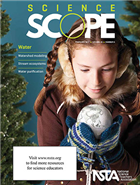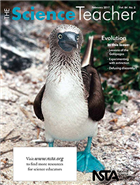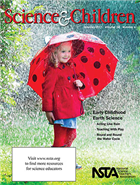Ideas and inspiration from NSTA’s February 2017 K-12 journals
By Mary Bigelow
Posted on 2017-02-19
All three journals this month include the inaugural Best STEM Books for Students K–12 with descriptions and reviews. The rubric and criteria used in selecting these books is also provided. Share it with your librarian, too.
Crowdfunding for Elementary Science Educators in S&C has fund-raising ideas applicable to any grade level.
 Science Scope — Water
Science Scope — Water
From the chemistry of water to the biology of water habitats and ecosystem to the relationship of water and weather to the importance of water in the body to current events related to access to clean water, water is indeed an Essential Substance.
Featured articles that describe lessons include a helpful sidebar (“At a Glance”) documenting the big idea, essential pre-knowledge, time, and cost. The lessons also include connections with the NGSS.
- Supporting Student Understanding of Watersheds by Using Multiple Models to Explore Elevation shows how a variety of models and maps can help students understand the flow of water in a watershed and its relation to elevation.
- If you are looking for a context in which to help students understand the concept of systems, take a look at Learning and Applying Systems Thinking When Studying a Local Creek System. The article includes student diagrams.
- From Fish Tank to Fuel Tank: Engineering Photobioreactors in the Classroom describes a multidisciplinary activity in which students grew algae as a potential source of renewable energy.
- Water, Water, Everywhere! But Is It Clean to Drink? Applying Engineering Design to the Challenge of Water Purification takes a problem-solving approach to this topic.
- The 5E lesson in An Inquiry Lesson on Stream Ecosystems shows students how the distribution of aquatic macroinvertebrates relates to the characteristics of a stream. There are suggestions for modifying this investigation if you aren’t near a stream, too.
- Science on a Shoestring: Testing the Waters includes directions for making and using a mini Secchi disk to measure water turbidity.
- With the Citizen Science: Citizen Science for a Rainy (or Snowy) Day project, your students can contribute to a national database of precipitation data, which can be used by the National Weather Service, NASA, USDA, researchers, and emergency management.
- Disequilibrium: Sticking Together has a 5E lesson on the cohesive properties of water.
- Teacher to Teacher: Designing the Water Treatment Process has a timely lesson on creating and testing models of treating water.
- Find ideas and suggestions from other teachers in this month’s Listserv Roundup: Teaching the Water Cycle.
For more on the content that provides a context for these projects and strategies see the SciLinks topics Algae, Aquatic Ecosystems, Eclipses, Freshwater Ecosystems, Groundwater, Ocean Water Chemistry, Photosynthesis, Water Cycle, Water Properties, Water Quality, Water Treatment, Watersheds
Continue for The Science Teacher and Science and Children
 The Science Teacher — Evolution
The Science Teacher — Evolution
The featured articles in this issue focus on evolution as a foundation and unifying theme of biology, helping us to understand the diversity of living things and how they are interconnected. In the Editor’s Corner: This View of Life, the editor shares advice for when a student has religious concerns for learning about evolution.
The lessons described in the articles include connections with the NGSS.
- In some communities, Evolution is a controversial topic. The commentary It’s About Time to Teach Evolution Forthrightly has suggestions for improving our teaching of evolution and supporting our colleagues to do so.
- Staying Within the Law addresses some of the legal implications of teaching evolution in public schools. A must-read!
- Defusing Discomfort describes a writing process that could be adapted to any controversial topic and provides an outlet for student views. The article includes examples of prompts related to evolution.
- Get ready for a virtual field trip. The 5E lesson in Lessons of the Galápagos explores the unique biology of these islands and how they were a “laboratory” for studying evolution.
- Experimenting With Extinction shows how students can design and test hypotheses about the extinction of cat species using historical data
- Career of the Month: Evolutionary Psychologist features an interview and description of this interdisciplinary field.
- Focus on Physics: Newton’s (Often Misunderstood) Third Law of Motion is an easy-to-read discussion that could be shared with students.
- The authors of Idea Bank: Skip the Cell Unit advocate for teaching about cells in context, rather than as an isolated unit focusing on the parts of a cell.
For more on the content that provides a context for these projects and strategies see the SciLinks topics Charles Darwin, Darwin and Natural Selection, Evolution, Evolution of Man, Evolutionary Biology, Extinction, Galapagos Islands, Natural Selection, Vertebrate Evolution, Newton’s Third Law
 Science & Children – Early Childhood Earth Science
Science & Children – Early Childhood Earth Science
Young children are full of curiosity and are eager to experiment (“play”) with objects and phenomena. Early intervention is a key to tapping into this curiosity. This issue has many ideas that are appropriate for young (and maybe not-so-young) students.
The lessons described in the articles include connections with the NGSS.
- In addition to a 5E lesson for student investigations, Acting Like Rain has charts that show how Pre-K activities can align with elementary NGSS and Common Core.
- Play is what children do best! Teaching With Play taps into their excitement with a lesson on environmental science (helping or hurting the environment) and pollution. The article includes photos of the children’s work.
- As an alternative to storybooks the author of Interactive Reading suggests how to incorporate informational texts into read-alouds for young children.
- It’s not too early to begin the Countdown to the Great American Eclipse, the first total solar eclipse in the continental US since 1979, especially since your school might not be in session on August 21.
- The Early Years: Looking at Landscapes has a lesson for using the playground as a lab for studying landforms and erosion.
- Teaching Through Trade Books: Focusing on Earth’s Features provides two 5E lessons for helping students model and understand landforms and patterns.
- Poetry of Science: Water, Water, Everywhere has ideas for combining science and language. Perhaps your students could create similar poems?
- The Science 101 column provides resources for the questions children ask. This month features Why Do We Only See One Side of the Moon?
- Integrating the Arts with the design process is the focus Engineering Encounters: From STEM to STEAM, as students design and test rollercoasters.
- Using age-appropriate activities and informational books, the author of Round and Round the Water Cycle describes how to craft learning activities that can be the foundation for future learning. Examples of student work are provided.
For more on the content that provides a context for these projects and strategies see the SciLinks topics Eclipses, Habitats, Landforms, Moon Phases, Plate Tectonics, Roller Coasters, Solutions to Pollution Problems, Volcanoes, Water Cycle, Watersheds
Disclaimer: The views expressed in this blog post are those of the author(s) and do not necessarily reflect the official position of the National Science Teaching Association (NSTA).


